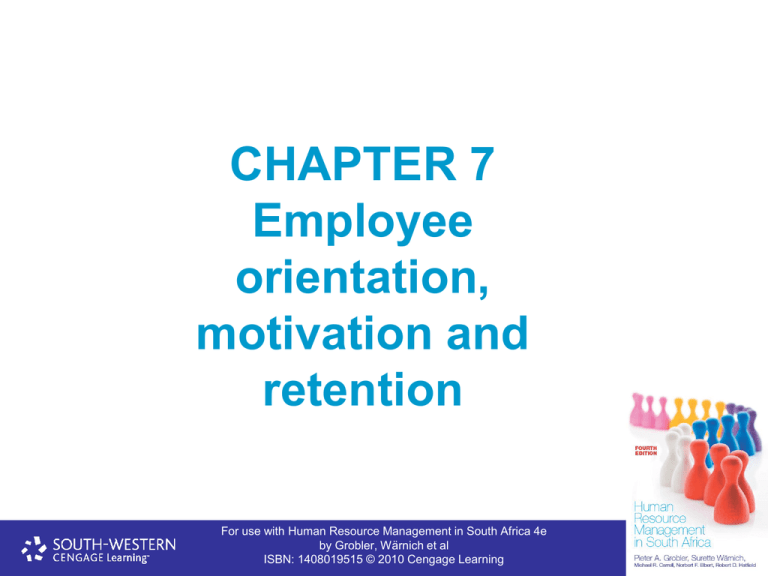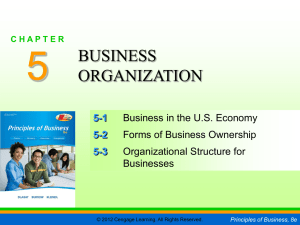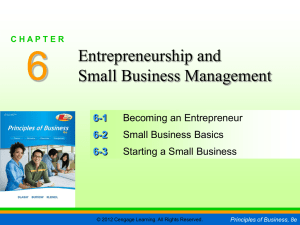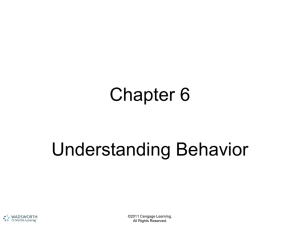Chapter 7 - Cengage Learning
advertisement

CHAPTER 7 Employee orientation, motivation and retention For use with Human Resource Management in South Africa 4e by Grobler, Wärnich et al ISBN: 1408019515 © 2010 Cengage Learning Chapter outcomes • explain the importance of orientation • design an orientation programme for a new employee, paying attention to shat it should contain, how it should be implemented, by whom and what timescale • explain why the evaluation of the orientation programme is important • discuss how motivation is linked to individual performance • list a number of motivational theories For use with Human Resource Management in South Africa 4e by Grobler, Wärnich et al ISBN: 1408019515 © 2010 Cengage Learning Chapter outcomes (continued) • discuss the practical implications of the various motivation theories • identify the changing nature of the psychological contract • list a number of retention determinants in four broad areas within the work context For use with Human Resource Management in South Africa 4e by Grobler, Wärnich et al ISBN: 1408019515 © 2010 Cengage Learning Definition •• Induction/orientation/socialisation – Induction/orientation/socialisation • Culture – • Culture – For use with Human Resource Management in South Africa 4e by Grobler, Wärnich et al ISBN: 1408019515 © 2010 Cengage Learning – Objectives of orientation • Acquainting new employees with job procedures • Establishing relationships with co-workers, including subordinates and supervisors • Creating a sense of belonging among employees by showing them how their job fits into the overall organisation • Acquainting new employees with the goals of the organisation • Indicating to the employees the preferred means by which these goals should be attained • Identifying the basic responsibilities of the job • Indicating the required behaviour patterns for effective job performance For use with Human Resource Management in South Africa 4e by Grobler, Wärnich et al ISBN: 1408019515 © 2010 Cengage Learning Model for orientation • Phase I – Anticipatory socialisation – – – – For use with Human Resource Management in South Africa 4e by Grobler, Wärnich et al ISBN: 1408019515 © 2010 Cengage Learning Model for orientation (continued) • Phase II – Encounter – – – – – For use with Human Resource Management in South Africa 4e by Grobler, Wärnich et al ISBN: 1408019515 © 2010 Cengage Learning Model for orientation (continued) • Phase III – Change and acquisition – – – For use with Human Resource Management in South Africa 4e by Grobler, Wärnich et al ISBN: 1408019515 © 2010 Cengage Learning Model for orientation (continued) • All three phases have also been labeled as “________”, “_________” and “_________” • Behavioural & attitudinal criteria used to measure progress • 3 essential types of behaviour: – – – For use with Human Resource Management in South Africa 4e by Grobler, Wärnich et al ISBN: 1408019515 © 2010 Cengage Learning Model for orientation (continued) • 3 affective outcomes: – – – For use with Human Resource Management in South Africa 4e by Grobler, Wärnich et al ISBN: 1408019515 © 2010 Cengage Learning Benefits of orientation • Job satisfaction • Labour turnover • Commitment to values and goals • Performance as a result of faster learning times • Costly and time-consuming mistakes • Absenteeism • Customer service through heightened productivity • Manager/subordinate relationships • Understanding of company policies, goals and procedures For use with Human Resource Management in South Africa 4e by Grobler, Wärnich et al ISBN: 1408019515 © 2010 Cengage Learning Reasons for the lack of effective orientation • The supervisors responsible for the task either lack the time or ability to fulfil this obligation • Organisations do not regard anxiety and stress, owing to insecurity and unfulfilled expectations, as a primary cause of labour turnover among new employees. They therefore consider orientation to reduce anxiety and stress as unnecessary • Organisations regard effective recruitment, selection, training and development as substitutes for orientation • Where orientation programmes are introduced, the key components are lacking For use with Human Resource Management in South Africa 4e by Grobler, Wärnich et al ISBN: 1408019515 © 2010 Cengage Learning Reasons for the lack of effective orientation (continued) • Orientation is aimed at inducing new employees to adhere to organisational practices and procedures while little attention is paid to instilling loyalty and commitment to the organisation • Employees who are transferred or promoted within the organisation are not subjected to orientation programmes • Orientation programmes are not followed up, i.e. the success of these programmes is not determined • Orientation programmes often concentrate on promoting the image of the organisation For use with Human Resource Management in South Africa 4e by Grobler, Wärnich et al ISBN: 1408019515 © 2010 Cengage Learning Responsibility for orientation • The supervisor – • The head of department – • The human resources department - For use with Human Resource Management in South Africa 4e by Grobler, Wärnich et al ISBN: 1408019515 © 2010 Cengage Learning Responsibility for orientation (continued) • A 'mentor' or 'buddy‘ – • The shop steward/staff representative – • New employees – For use with Human Resource Management in South Africa 4e by Grobler, Wärnich et al ISBN: 1408019515 © 2010 Cengage Learning Who should be given orientation training? • New employees – • Transferred/promoted employees – • All current employees - For use with Human Resource Management in South Africa 4e by Grobler, Wärnich et al ISBN: 1408019515 © 2010 Cengage Learning Scope of orientation training • Two levels: – General organisational orientation – affect all employees in the organisation – Specific departmental orientation – tailored to the new employee’s specific department • Employee handbook – review regularly, guard against too much detail, mention topics briefly, could also be on website For use with Human Resource Management in South Africa 4e by Grobler, Wärnich et al ISBN: 1408019515 © 2010 Cengage Learning Approaches in orientation • 1 Formal Orientation • 2 Informal Orientation • There are also three basic approaches: – – – For use with Human Resource Management in South Africa 4e by Grobler, Wärnich et al ISBN: 1408019515 © 2010 Cengage Learning Approaches in orientation • Informal orientation: – Self-directed orientation – employee is encouraged to discover information on their own regarding the organisation (can be by means of company Intranet) For use with Human Resource Management in South Africa 4e by Grobler, Wärnich et al ISBN: 1408019515 © 2010 Cengage Learning How long should the orientation training be? • Avoid cramming all orientation (detailed information) into one long session • Sessions should not be longer than 2 hours • Period of orientation should be linked to time it takes to become effective • Follow-up sessions are important after ± 2 months For use with Human Resource Management in South Africa 4e by Grobler, Wärnich et al ISBN: 1408019515 © 2010 Cengage Learning Planning an orientation programme • Developing orientation programme takes 3-6 months • Key planning considerations: – Orientation policy – Budget – Other planning considerations • Time needed to plan & implement For use with Human Resource Management in South Africa 4e by Grobler, Wärnich et al ISBN: 1408019515 © 2010 Cengage Learning Planning an orientation programme (continued) – Other planning considerations - A number of other aspects must also be considered: (continued) • Programme goals, topics to be included, methods of organising and presenting them, duration of orientation sessions • Materials, facilities and personnel to be used • General organisation topics versus department and job topics to be covered • Qualifications and training needs of human resources personnel, line managers and supervisors • Programme flexibility to accommodate employee differences in education, intelligence and work experience For use with Human Resource Management in South Africa 4e by Grobler, Wärnich et al ISBN: 1408019515 © 2010 Cengage Learning Designing an orientation programme • Different groups in the organisation require different orientation programmes (eg. management & non-management) • Design programme to include all the information the newcomer will “need to know” and the “nice to know” as well • “Need to know” – information the newcomer requires as soon as possible to fit in & be effective • “Nice to know” – can be given over a period of time as they settle in For use with Human Resource Management in South Africa 4e by Grobler, Wärnich et al ISBN: 1408019515 © 2010 Cengage Learning Designing an orientation programme (continued) • Categories of information: – Job-related information – – General information - For use with Human Resource Management in South Africa 4e by Grobler, Wärnich et al ISBN: 1408019515 © 2010 Cengage Learning Implementing the orientation programme • Steps: – Pre-employment preparation – Pre-employment information – 1st day instructions - For use with Human Resource Management in South Africa 4e by Grobler, Wärnich et al ISBN: 1408019515 © 2010 Cengage Learning Implementing the orientation programme (continued) • Steps: (continued) – The welcome pack – Organising the work - For use with Human Resource Management in South Africa 4e by Grobler, Wärnich et al ISBN: 1408019515 © 2010 Cengage Learning Implementing the orientation programme (continued) • Steps: (continued) – Briefing colleagues – – Administrative arrangements – – Training – – The first day orientation – – On arrival – – Basic information – For use with Human Resource Management in South Africa 4e by Grobler, Wärnich et al ISBN: 1408019515 © 2010 Cengage Learning Implementing the orientation programme (continued) • Steps: (continued) – The initial discussion – – Building the relationship – – Immediate supervisor – – The buddy or mentor – For use with Human Resource Management in South Africa 4e by Grobler, Wärnich et al ISBN: 1408019515 © 2010 Cengage Learning Evaluation of the orientation programme • Benefits: – To ensure that the organisation is spending its money wisely and achieving positive results – That the methods used to assist new employees to integrate and become effective workers in the organisation are the most suitable For use with Human Resource Management in South Africa 4e by Grobler, Wärnich et al ISBN: 1408019515 © 2010 Cengage Learning Evaluation of the orientation programme • Use questionnaires, surveys, exit interviews and course evaluation forms, qualitative information can also be gathered: – Who should be involved? – What will be measured? For use with Human Resource Management in South Africa 4e by Grobler, Wärnich et al ISBN: 1408019515 © 2010 Cengage Learning The problems with orientation programmes • • • • • • • • Too much emphasis on paperwork Information overload Scare tactics Too much selling of the organisation Emphasis on formal, one-way communication One-shot mentality No diagnosis or evaluation of the programme Lack of “follow-up” For use with Human Resource Management in South Africa 4e by Grobler, Wärnich et al ISBN: 1408019515 © 2010 Cengage Learning Motivation • Definition: – For use with Human Resource Management in South Africa 4e by Grobler, Wärnich et al ISBN: 1408019515 © 2010 Cengage Learning Motivation • Completing the orientation process does not guarantee satisfactory employee performance • Many factors affect performance abilities, efforts expended & continued organisational support received • HR should analyse and address these areas For use with Human Resource Management in South Africa 4e by Grobler, Wärnich et al ISBN: 1408019515 © 2010 Cengage Learning Motivation • Motivators are specific to an individual • A manager should attempt to meet the employee’s important needs/basic requirements for worker productivity • Increased diversity of workforce For use with Human Resource Management in South Africa 4e by Grobler, Wärnich et al ISBN: 1408019515 © 2010 Cengage Learning Maslow’s hierarchy of needs _______________ needs _______________ needs _______________ needs _______________ needs _______________ needs For use with Human Resource Management in South Africa 4e by Grobler, Wärnich et al ISBN: 1408019515 © 2010 Cengage Learning Alderfer’s ERG theory • Closely related to Maslow’s hierarchy of needs • ____________ (existence, relatedness and growth) • Differences do exist, however • Alderfer proposes that, when one need is frustrated, we simply concentrate on the others For use with Human Resource Management in South Africa 4e by Grobler, Wärnich et al ISBN: 1408019515 © 2010 Cengage Learning Achievement motivation • David McClelland • 3 needs are emphasised: achievement, affiliation & power – The need to achieve (N ach) - For use with Human Resource Management in South Africa 4e by Grobler, Wärnich et al ISBN: 1408019515 © 2010 Cengage Learning Achievement motivation (continued) – The need for affiliation (N aff) – The need for power (N pow) • N aff + N pow strong • N Ach + N pow For use with Human Resource Management in South Africa 4e by Grobler, Wärnich et al ISBN: 1408019515 © 2010 Cengage Learning Goal setting • Edwin Locke • Job performance can be increased through goal setting - when individuals are given measurable goals rather than vague performance standards • Best-known expression of goal setting theory is _________________________________ For use with Human Resource Management in South Africa 4e by Grobler, Wärnich et al ISBN: 1408019515 © 2010 Cengage Learning Goal setting (continued) • Goal-setting strategies involve a systematic process manager & subordinate discuss and agree on a set of jointly determined goals • Present a case for or against each goal • Final result - a set of goals that is in keeping with the overall goals of the organisation • Feedback on progress is periodically supplied, enabling the worker to make necessary corrections • Link between performance & rewards is clear (emphasis on what is achieved rather than on how) For use with Human Resource Management in South Africa 4e by Grobler, Wärnich et al ISBN: 1408019515 © 2010 Cengage Learning Positive reinforcement • The practice of giving valued rewards to someone who has just engaged in a desired behaviour • Law of effect • Reinforcement is at the heart of merit increases • For reinforcement to continue to affect employees’ future behaviour manager must make certain that rewards are meaningful and desired by each employee • Manager must tailor the reward, whether it be recognition, pay or changing job requirements, to fit the employee • Manager must be sure that employees realise that rewards are contingent on correct behaviour. For use with Human Resource Management in South Africa 4e by Grobler, Wärnich et al ISBN: 1408019515 © 2010 Cengage Learning Herzberg’s two-factor theory • Frederick Herzberg • Motivator-hygiene factors - applied to the workplace and job design • Herzberg noticed that people identified different things as sources of work dissatisfaction (__________ factors) from those that were sources of satisfaction (____________) • Satisfaction and dissatisfaction not simple opposites For use with Human Resource Management in South Africa 4e by Grobler, Wärnich et al ISBN: 1408019515 © 2010 Cengage Learning Herzberg’s two-factor theory (continued) Hygiene needs - job environment creates demand for Motivator needs + job opportunities allow workers to achieve Hygiene factors: Level of job dissatisfaction More money, better supervision, good working conditions etc Level of job performance Motivators: Level of job satisfaction Achievement, responsibility, growth, work itself, recognition For use with Human Resource Management in South Africa 4e by Grobler, Wärnich et al ISBN: 1408019515 © 2010 Cengage Learning The psychological contract definition • The psychological contract – For use with Human Resource Management in South Africa 4e by Grobler, Wärnich et al ISBN: 1408019515 © 2010 Cengage Learning Individual/organisational relationships • The psychological contract - entails beliefs about what employees believe they are entitled to receive because they perceive their employer promised to provide these things – Unwritten For use with Human Resource Management in South Africa 4e by Grobler, Wärnich et al ISBN: 1408019515 © 2010 Cengage Learning Individual/organisational relationships (continued) • The psychological contract – Violations of the psychological contract – Changing of the psychological contract – Practical implications for companies regarding psychological contracts For use with Human Resource Management in South Africa 4e by Grobler, Wärnich et al ISBN: 1408019515 © 2010 Cengage Learning Retention of human resources • • • • For use with Human Resource Management in South Africa 4e by Grobler, Wärnich et al ISBN: 1408019515 © 2010 Cengage Learning Summary • • • Starting a new job is not easy. It is important that careful attention be paid to the introduction of the new employee to the organisation, his or her co-workers and his or her job. This is also applicable to transferred and promoted employees. The method to achieve this is by means of a well-designed orientation programme. To implement the programme successfully requires the joint effort of the HR department, the line managers and the existing employees. While the first day of the new employee at the organisation is critical, there are limits to what can be achieved and the orientation will often have to be spread over a longer period. For use with Human Resource Management in South Africa 4e by Grobler, Wärnich et al ISBN: 1408019515 © 2010 Cengage Learning Summary • When planning the orientation programme, it is important to note not only the content of the programme but also the best way of handling it. The programme will also have to be monitored regularly to correct any problems and to see whether any redesign is necessary. • Successful orientation will lead to better-motivated employees and higher productivity within the organisation. • After orientation has been completed, it is important that the employee receives proper training in order to improve his or her skills within the job environment. • Individual performance components include individual ability, effort expended and organisational support. For use with Human Resource Management in South Africa 4e by Grobler, Wärnich et al ISBN: 1408019515 © 2010 Cengage Learning Summary • • • Motivation deals with the needs and desires of human behaviour. Various theories of motivation have been developed. A psychological contract contains the unwritten expectations that employees and employers have about the nature of their work relationship. Those contracts are changing along with employee loyalty to their employers. Retention of employees is a major focus of HR efforts in organisations. The determinants of retention can be broadly divided into four categories. For use with Human Resource Management in South Africa 4e by Grobler, Wärnich et al ISBN: 1408019515 © 2010 Cengage Learning





